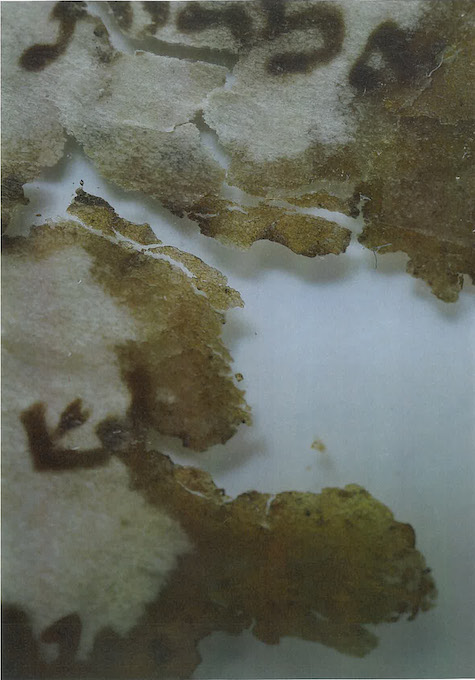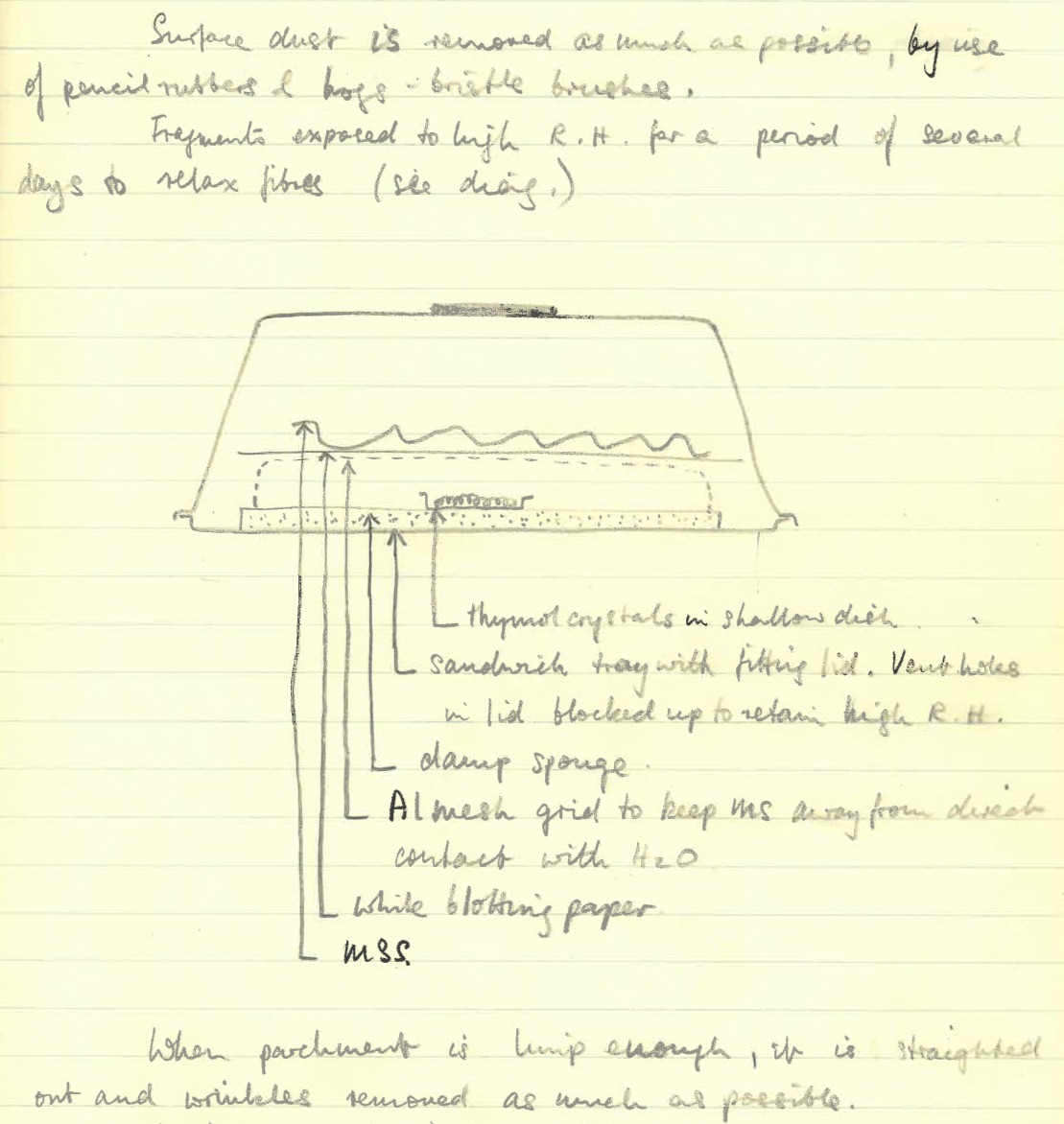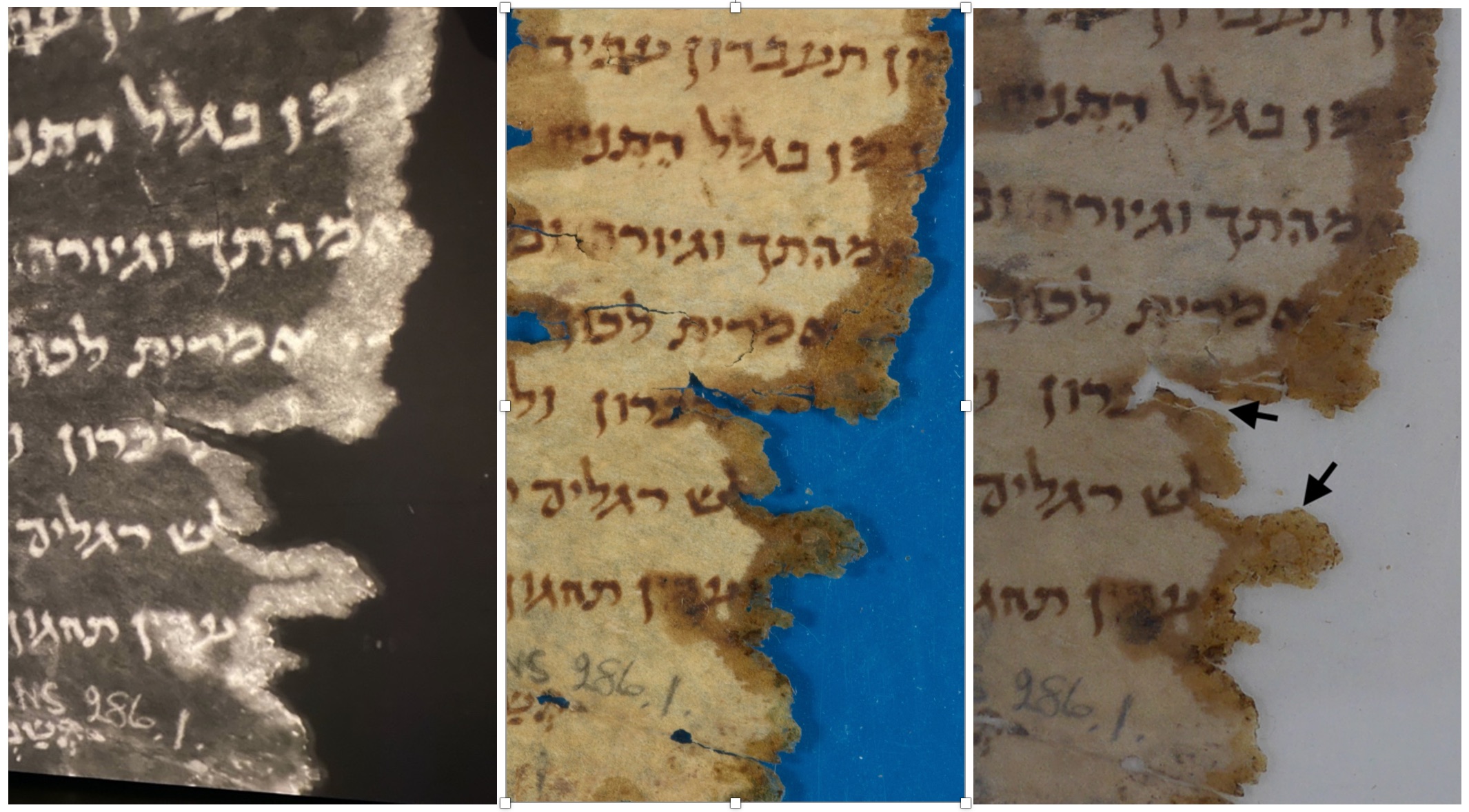Q&A Wednesday: Gelatinisation of early parchment fragments in the T-S New Series, with Deborah Farndell

In 2014, UL conservator Mary French was asked to examine a parchment fragment in the New Series which had been encapsulated with a small piece of parchment folded over and obscuring a word. When she opened the Melinex pocket she was perplexed to find that some areas of the parchment were translucent, sticky, and unexpectedly pliable. Concerned that it might mean there was a humidity issue in the manuscript storage room, Mary measured the relative humidity levels and found they were elevated in areas near to some air vents. These vents were capped, and in 2016, our Conservation and Collection Care department introduced a new programme to expand the monitoring of humidity and temperature within Special Collections storage areas. Deborah Farndell, UL Senior Conservator, has since been examining the fragment Mary found along with several others that exhibited similar characteristics, and possible solutions. Deborah, when you examined the affected fragments, what did you see?
In 2017 I first looked at two of the fragments in more detail firstly to see if it was possible to safely remove them from the Melinex housing and secondly to establish if they could be re-housed in a way that made them still accessible. My initial observations were that some of the edges of the parchment had become discoloured and gelatinised, turning into a thin, glass-like brittle material. It was sticking to the Melinex in small, localised areas. This was very alarming as I had never seen this phenomenon before and was not sure of the cause or extent of it or whether it would get worse if nothing was done in the immediate future. Another major concern was the housing used for these fragments. They are housed in large folders with long landscape pages. When the pages are flexed, the brittle parchment cracks and fragments further. In some cases, this has led to a loss of script.
The fragments affected are parchment, and certainly on the older and potentially rarer end of the spectrum for Genizah manuscripts. One of the fragments affected is T-S NS 286.1, a fragment of Palestinian Targum (a rare text only preserved in the Cairo Genizah). What is the outcome for a fragment diagnosed with this kind of gelatinisation?
Once gelatinisation has occurred in parchment, it cannot be reversed and sadly, gelatinisation of parchment in cultural heritage items is not unique to our collections. The collagen has turned into gelatine, giving the fragment different material properties and making it a lot more vulnerable to changes of humidity and temperature. It is also incredibly brittle and prone to fragmenting during handling. Conservation treatments involving moisture or solvents become extremely high risk. As gelatine is not a stable support for manuscript text, due to its brittleness and tendency towards extreme shrinkage as it dries, gelatinisation can eventually cause parts of the manuscript literally to vanish.
When the problem was first found we wondered if it might be caused by fluctuations in the ambient temperature and humidity. Although this was ruled out in the context of the storage environment in the manuscript stacks, differences in temperature and humidity between the stacks and the reading room could be a contributing factor. Another possibility was that the problem was caused during the conservation process for certain fragments. To investigate the conservation methods used in the ‘New Series’ part of the T-S Collection, we’ve looked in the notebooks kept by the Conservation team in the 1960s and 1970s. In Nov. 1967, there are detailed notes for the work that will be undertaken on the NS, with a helpful diagram for the ‘relaxation’ of the fragments.

Detail from conservation report from 1967. To relax the parchment, fragments were exposed to high relative humidity for a short period of time but at no point was water allowed to come into direct contact with the fragment. After a preliminary drying out time, the fragment is flattened out, then cleaned, mended, and allowed to dry further before encapsulation in Melinex, then microfilmed. The conservation notebooks reveal the immense scope and pace of the project, in the face of time, space, and staffing constraints.
Deborah, what are your impressions when reading about the work that was carried out on the fragments?
It was amazing to see the conservation notes from the 60s and 70s. Seeing the handwriting and the diagrams showing the treatment processes and reading about the workflows of the teams involved gave a great insight into the scale of the project and the challenges they faced. Some of the humidification methods carried out then would be seen as too drastic by today’s standards and probably contributed to the gelatinisation of the parchment. It is interesting to note that from looking at the microfilm images taken in the 60s and 70s after conservation treatment, the gelatinisation of the parchment can already be seen.
Aside from storage or treatment, are there any other factors that might have contributed to this problem in certain manuscripts?
There are many factors that can contribute to the lead up gelatinisation of parchment. For example, the type of animal used, the diet of the animal, the production methods used during the parchment making process, the age of the parchment, its historical storage and use, current storage and use and historical and current conservation treatments. All these factors could influence the strength of the collagen fibres and its susceptibility to damage. Because of this, the fragments do not all display the same symptoms or severity of damage. Each one will react differently accordingly. However, ultimately the most consistent cause of pre-gelatinisation damage is the environment a fragment has been exposed to in its lifetime (e.g., heat, moisture and environmental pollutants), and the only known cause of the transition from a pre-gelatinised state to full gelatinisation is exposure to water.
To try to find out when gelatinisation occurred in T-S NS 286.1, we compared the microfilm image of the fragment with its image taken during digitisation (between 2009–2012), with its current state. The gelatinisation doesn’t appear to have encroached in the last decade or so since digitisation, but there does seem to have been some encroachment since the microfilm was made (soon after encapsulation in melinex, which in turn was done soon after conservation).

T-S NS 286.1 in the microfilm (taken in the early 1970s), during digitisation (2009-2012) and today. Some advancement of the gelatinised area is visible.
Deborah, is there a way to determine which fragments have been affected by this, or are likely to be affected in future?
There are studies which show that there are different degrees of deterioration of parchment leading up to the gelatinisation stage. Unfortunately, the gelatinised stage we can see with the naked eye in these fragments is the final stage and all the other stages leading up to this stage (pre-gelatinised) are only visible with microscopes and by taking samples. At the present moment it is not possible to safely and accurately determine how much of the parchment is at the pre-gelatinized stage or its degree of deterioration. This analysis involves taking a sample albeit small, 0.020mm, which is a destructive process and something we would not recommend, apart from in exceptional circumstances and only after a detailed risk-benefit analysis. Technology and research is ever advancing in this field, but it is not quite there. It is only recently that non-destructive analysis of the extracted parchment samples has been developed. It is hoped that in the near future, accurate identification of the stages of pre-gelatinised parchment without removal of sample materials from historical documents will enable us to make more informed decisions about appropriate treatments, storage and the use of these rare fragments, but this can only happen if more research is carried out.
What needs to happen next?
This is really a conversation to have with the curators, but I would say the collection needs to be surveyed and the fragments that are at immediate risk – such as the ones I looked at in 2017 – identified. A good idea may be to use the digital images we already have as this would reduce the need to handle the fragments. Depending on the extent and particular items affected a rehousing programme may be needed. The folders containing these fragments should have reduced handling and digital copies used instead for research. Parchment in a pre-gelatinised state or gelatinised state can be kept from deteriorating further by being stored in certain climate controlled environmental conditions, so it is absolutely critical for these fragments in this state that strict controlled climate conditions are adhered to, and this should be addressed further. In order to gain full access to them an awful lot more work is needed.
Thanks for your time, Deborah!
Deborah Farndell is a senior conservator at Cambridge University Library.

Add new comment